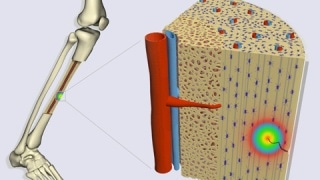Jan 22 2018
Researchers at the Institut Català de Nanociència i Nanotecnologia (ICN2), a Severo Ochoa research center based at the UAB Campus and member of the Barcelona Institute of Science and Technology (BIST), have discovered that bone is also flexoelectric. They suggest the possible role of flexoelectricity in the regeneration of bone tissue in and around the type of microfractures incurred in bones on a day-to-day basis.
The ICN2 Oxide Nanophysics Group headed by ICREA Prof. Gustau Catalan reports these findings in the Jan 19th issue of Advanced Materials, with key author Fabián Vásquez-Sancho. The work has possible implications for the development of biomimetic self-healing materials and the prosthetics industry.
 Researchers have discovered that bone is flexoelectric, which therefore has a possible role in the regeneration of bone tissue in and around microfractures.
Researchers have discovered that bone is flexoelectric, which therefore has a possible role in the regeneration of bone tissue in and around microfractures.
Bones were already known to produce electricity under pressure, stimulating remodeling and self-repair. Initially reported in the late fifties, this was first attributed to the piezoelectricity of bone’s organic component, collagen. In the meantime, studies have since then observed markers of bone repair in the absence of collagen, signifying that other effects are at play. In this work, ICN2 researchers have indeed revealed such an effect: the flexoelectricity of bone’s mineral component.
Flexoelectricity is a property of some materials that makes them to emit a small voltage when a non-uniform pressure is applied. This response is very localized, becoming weaker as one moves away from the point of maximum stress. In microfractures, it is localized to the leading edge or tip of the crack, an atomically small site that, by description, focuses on the maximum strain a material is capable of withstanding before complete rupture. The outcome is a flexoelectric field of such magnitude that, in the close vicinity of the crack, it conceals any background collagen piezoelectric effect.
By learning about strain gradients in pure bone mineral (hydroxyapatite) and bones, the researchers succeeded in calculating the precise magnitude of this electric field. Their findings specify that it is sufficiently large within the necessary 50 μm of the crack tip to be sensed by the cells that bring about bone repair, directly involving flexoelectricity in this process.
Additionally, since the cells responsible for synthesizing new bone tissue (osteoblasts) are known to fasten close to the tip, it would appear as if the electric field distribution signals this point as the center of damage, turning into a moving beacon for repair efforts as healing of the crack takes place.
These results prove to be promising for the prosthetics industry, where new materials that amplified or reproduced this flexoelectric effect could be employed for guiding tissue regeneration, resulting in a more successful assimilation of implants.
The study received funds from an European Research Council grant, and has been guided from the ICN2 with the association of the Materials Science and Engineering Research Centre at the Universidad de Costa Rica (Costa Rica), the Computational Methods and Numerical Analysis Laboratory (LaCàN) at the Universitat Politècnica de Catalunya (Spain), and the École Politechnique Federale de Lausanne (EPFL, Switzerland).